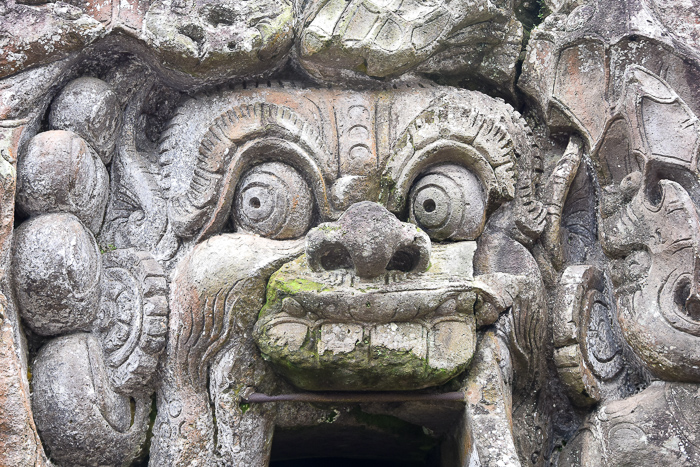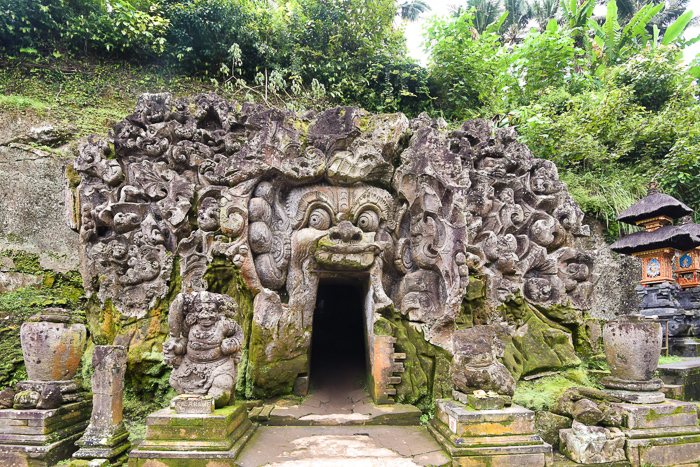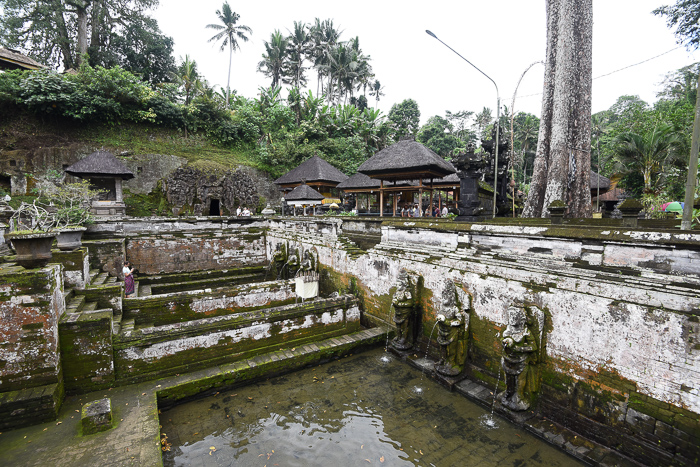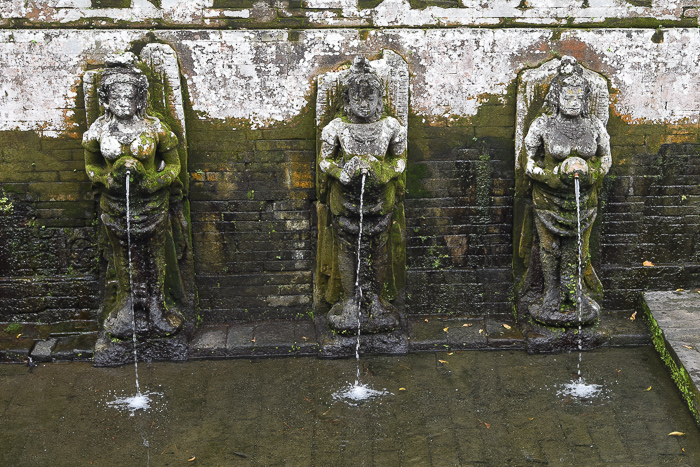Goa Gajah (Elephant’s Cave) of Bali, Indonesia

Goa Gajah, the “Elephant’s Cave,” is one of Bali’s oldest and most enigmatic sanctuaries. It comprises a T-shaped cave grotto, a monumental baroque entrance, a restored bathing pool of ancient origins, and the modern Pura Taman temple.
Although one of Bali’s most popular sites on the tourist circuit today, it was completely unknown to all but locals until its “rediscovery” by Dutch archaeologists in 1922-1923.
A few decades later, in what Kempers describes as “one of the greatest surprises of archaeological work in Bali after World War II,” the bathing complex was rediscovered, cleared of a thousand years of mud and debris, and restored to working order.
The age of the site is not known with certainty. Unlike the nearby Gunung Kawi, there are no monumental inscriptions providing direct textual evidence for modern archaeologists. The best there is to work with is graffiti inside the mouth of the artificial cave, carved with the words kamon (or kumon) and sahy (va)angsa. The meaning is unknown, but the writing style is consistent with late 11th-century inscriptions.

Thus, we can infer the cave was in existence by at least that date, which is coincident with the reign of King Anak Wungsu, a powerful ruler who reigned from 1050 through at least 1078 (and who himself may be immortalized in the form of the Gunung Kawi rock-hewn candis).
While Kempers proposed this date, the noted archaeologist Jacques Dumarçay independently arrived at the same conclusions, describing this era as the “Javanese Period of Bali.”
Early references to Goa Gajah are found in later texts dating to the era of Bali’s classical kingdoms (9th-14th centuries). Among them, the 1365 Nagarakrtagama notes the existence of a place called Lwa Gajah, “Elephant Water,” near modern-day Bedulu, which is only a few hundred meters from Goa Gajah.
Kempers surmises that the Goa Gajah cave may have received its name in reference to Lwa Gajah near Bedulu. However, the term “Elephant Cave” apparently confused early Dutch archaeologists, who mistook the large face carved over the cave’s entrance as the head of an elephant sans trunk.
In fact, the stylized and monstrous face over the entrance is probably a Balinese witch, perhaps an early form of the demoness Rangda, famed throughout Bali. Its position directly over the cave entrance recalls the practice of placing Bhoma or Kala heads over temple entrances.
The intent was likely the same—to scare off malevolent entities or spiritual beings who might otherwise do harm. To this end, the cave also seems to have been augmented with an aling-aling, a screen wall set up in front of the entrance to ward off demons, who were thought to only be able to travel in straight lines. However, the aling-aling is no longer extant today.
Another interpretation is that the face represents a cosmic force pushing apart the rocks, creating an opening similar to the gap between the two halves of candi bentar temple gates. Kempers highlights a similarity to the legend of Siva Pasupati, who created the “rival” mountains of Batur and Agung by pushing them apart from a single mass.
This argument is reasonably convincing, as the visitor can readily see four of the witch’s fingers straining to push aside one of the walls of rock, as if she is emerging from a subterranean lair. Flanking her face, the remainder of the rock wall appears to be a chaotic mountain forest scene filled with highly stylized leaves. Hidden amongst them are vignettes of living creatures, including leering goblins, a snake emerging from a rock, and several figures climbing their way across the “leaves”.
The cave’s interior is shaped like a “T,” with the long end of the T comprising the entrance tunnel, with two sections branching off at the ends. Along the entrance corridor are rectangular niches that Kempers suggest might have served as sleeping spaces.
However, this is hard to imagine, as there is no air circulation inside the passages, and at present, the air is extraordinarily foul from accumulated smoke and incense. Further back into the artificial cave, the situation is even worse; it is difficult to remain inside without feeling suffocated.
Here, one may glimpse (albeit briefly) a statue of Ganesha at one end and a trio of lingas at the other. While both are emblematic of Shiva, it is unknown if the figures were set there by the original builders or if they were moved there in later centuries.
To the modern visitor, the vast bathing pool is the first feature one sees when descending the stairs to Goa Gajah. However, as late as the 1950s, both locals and professional archaeologists were unaware of the pool’s existence, as it was filled in with earth and covered with vegetation. Only a few stone steps and the puzzling presence of stone spouts (which were apparently removed from the bathing pool, ages ago) suggested the existence of other structures.

In 1954 the Dutch archaeologist Krijgsman excavated the area around the stairs and removed the accumulated debris, revealing the bathing pool. The spout fragments were restored to their original location, and Kriijgsman’s workers cleaned and reconnected the ancient water supply. He was so enamored of the site that he used the bathing pool for his daily baths, until it was declared off-limits to bathers to protect its integrity (and to prevent the site from being profaned).
The bathing area is divided into three zones: a central rectangular pool flanked by two larger square pools. The middle pool has not been restored as it is not clear how it was used; currently it is only partly filled with water and is not fed by its own water source.

The two side pools may have been segregated by gender, but this is speculative. Each is fed by three full-size nymphs which appear to poor endless streams of water from basins held against their midriffs. Access to the pools are via broad stairways that allow bathers to enter regardless of the water level.


